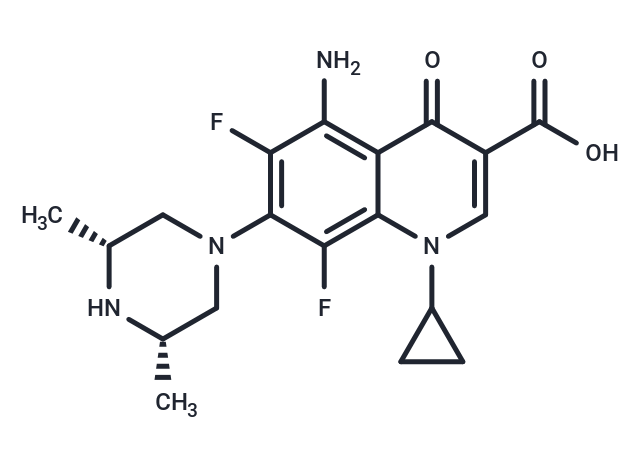Shopping Cart
Remove All Your shopping cart is currently empty
Your shopping cart is currently empty
Sparfloxacin (CI-978) is a fluoroquinolone antibiotic that inhibits bacterial DNA gyrase, thus preventing DNA replication and transcription.

| Pack Size | Price | USA Warehouse | Global Warehouse | Quantity |
|---|---|---|---|---|
| 500 mg | $40 | In Stock | In Stock | |
| 1 g | $52 | In Stock | In Stock |
| Description | Sparfloxacin (CI-978) is a fluoroquinolone antibiotic that inhibits bacterial DNA gyrase, thus preventing DNA replication and transcription. |
| In vitro | Orally administered Sparfloxacin produces favorable therapeutic outcomes in mice with systemic infections caused by Staphylococcus aureus, Streptococcus pyogenes, Streptococcus pneumoniae, Escherichia coli, and Pseudomonas aeruginosa. |
| In vivo | Sparfloxacin targets DNA gyrase, inhibiting DNA synthesis. It exhibits potent, broad-spectrum antimicrobial activity, effective against Gram-positive bacteria such as Staphylococcus, Streptococcus, and Enterococcus species (MIC=0.1 to 0.78μg/ml), Gram-negative bacteria including Enterobacteriaceae and Pseudomonas species (MIC=0.0125 to 1.56μg/ml), glucose non-fermenters (MIC=0.025 to 0.78μg/ml), Legionella (MIC=0.0125 to 0.05μg/ml), and anaerobes (MIC=0.2 to 0.78μg/ml). |
| Synonyms | Zagam, PD 131501, CI-978, AT-4140 |
| Molecular Weight | 392.40 |
| Formula | C19H22F2N4O3 |
| Cas No. | 110871-86-8 |
| Smiles | FC1=C2C(C(=O)C(C(O)=O)=CN2C3CC3)=C(N)C(F)=C1N4C[C@H](C)N[C@H](C)C4 |
| Relative Density. | 1.436g/cm3 |
| Color | Yellow |
| Appearance | Solid |
| Storage | Powder: -20°C for 3 years | In solvent: -80°C for 1 year | Shipping with blue ice/Shipping at ambient temperature. | ||||||||||
| Solubility Information | DMSO: 1 mg/mL (2.55 mM), Sonication is recommended. Ethanol: < 1 mg/mL (insoluble or slightly soluble) H2O: < 1 mg/mL (insoluble or slightly soluble) | ||||||||||
Solution Preparation Table | |||||||||||
DMSO
| |||||||||||
| Size | Quantity | Unit Price | Amount | Operation |
|---|

Copyright © 2015-2025 TargetMol Chemicals Inc. All Rights Reserved.